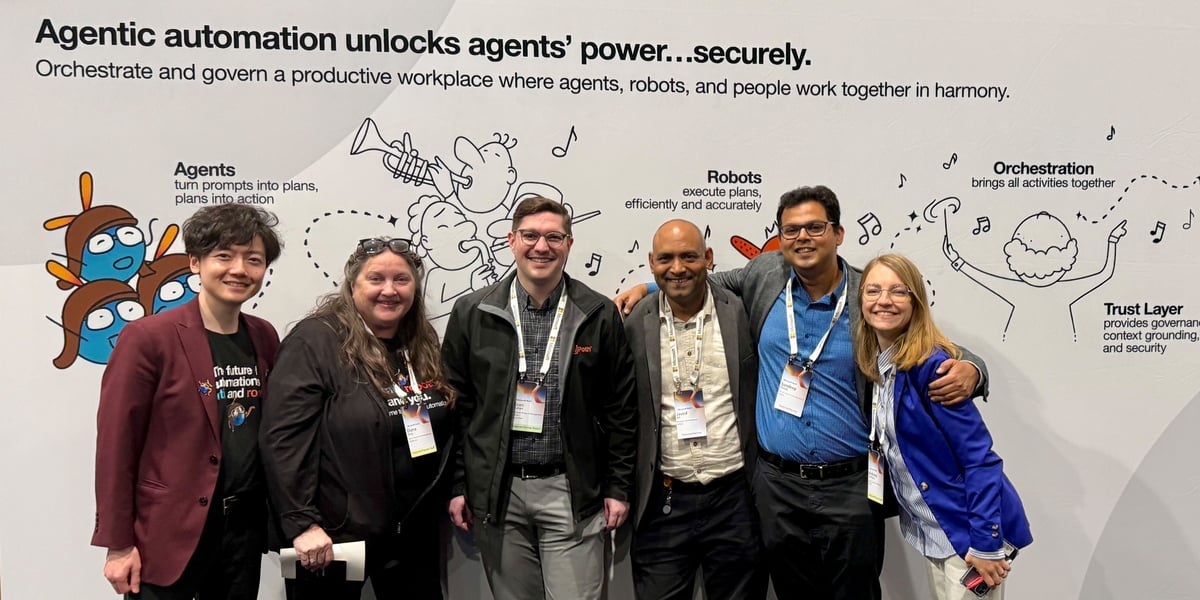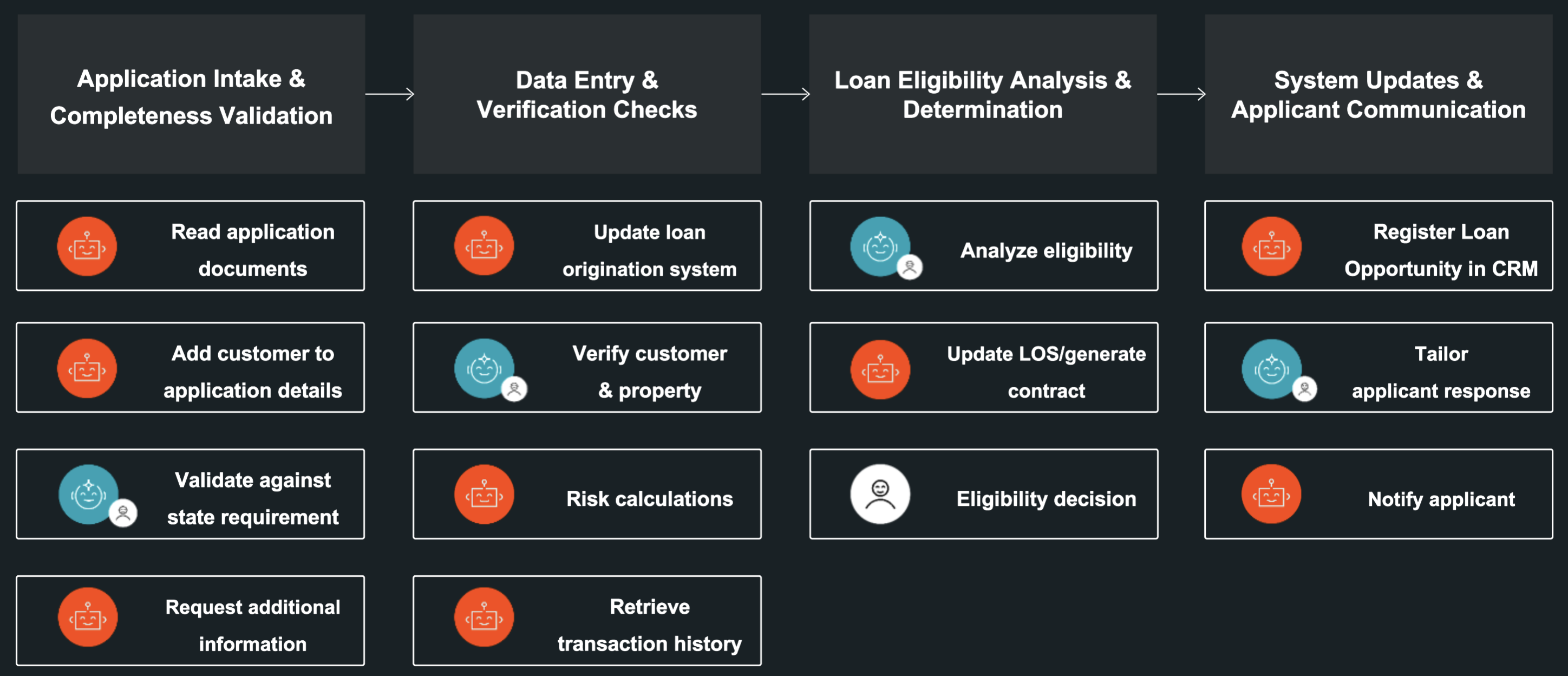AI agents took center stage at Microsoft Build
Share at:

We're back from Microsoft Build 2025, and if there’s one thing that was impossible to miss: agentic AI is everywhere. Everyone’s talking about it, building it, testing it—and we’re right there in the thick of it, bringing real-world agentic automation to life.
At the UiPath booth, the energy was high. People didn’t just want to hear about AI agents reasoning and chatting. They wanted to see what it looks like when AI agents, robots, and people actually work together to move a business process forward.
And we delivered.
AI that doesn’t just think—it gets things done
Let’s take loan origination as an example. It’s a messy, multi-step process. It involves scanning documents, pulling data from various systems, checking eligibility, talking to customers—the kind of work that’s ripe for automation, but too complex for any one AI agent to handle solo.

That’s where agentic automation comes in. Picture this:
A UiPath Agent kicks things off, using robots to grab data and tools like UiPath IXP (Intelligent Xtraction and Processing) to understand scanned IDs, bank statements, or PDF forms.
It checks basic eligibility criteria and performs initial data entry.
But when it is time to write a customer-friendly message or apply nuanced judgment, it’s a person’s turn—assisted by Microsoft 365 Copilot for content generation or Salesforce Agentforce, which has richer customer context.
Each agent does what it’s best at. That’s agentic automation in action.
Seamless handoffs with bidirectional integrations
For seamless handoffs between agents, you need bi-directional connectivity. At Microsoft Build, we were especially proud to show the bi-directional integration between UiPath Agents and Microsoft Copilot Studio in action. In plain terms: we’ve made it easier than ever for Microsoft and UiPath agents to talk to each other, hand off tasks, and collaborate across platforms.
UiPath Agents that specialize in working across multiple systems and understanding semi-structured documents can now trigger Copilot Studio agents or Power Automate flows which reason over data in Microsoft Graph or Dataverse, generate content in Microsoft 365 apps, or take action that needs multiple Dynamics objects as context.
Copilot Studio agents can also call on UiPath agents or automations for downstream execution—think “Process this claim” or “Check if this part exists in any of my ERPs.” This integration brings together two powerful agentic capabilities to enable customers to automate end-to-end processes.
And behind it all is UiPath Maestro™, a unified process orchestration layer, helping you manage your processes across AI agents, robots, and people with a single pane of glass. This cross-platform orchestration unlocks new levels of productivity and contextual decision making across the Microsoft and UiPath ecosystems.

Real results: 500% ROI and thousands of hours saved
Take Johnson Controls, for example. They started with automation built in UiPath and Microsoft Power Automate. After plugging in agentic capabilities using our new integration, they saw a 500% additional return on investment and gave 18,000 hours back to the business each year.
That’s not a proof of concept. That’s real business value—delivered at scale.
Controlled agency: the right work, done by the right worker
Here’s something we’ve learned: adaptability comes at the cost of occasional errors. You can unleash the full potential of an LLM when someone is constantly supervising an AI assistant. But for real agency, you need to trust an AI agent to “do its thing” with accuracy and reliability. .
That’s why agentic automation needs controlled agency. It means deploying agents with the evaluations, tools, and escalation guardrails for complex tasks. But AI agents hand off deterministic and repetitive tasks to a robot to execute those tasks with precision. And when judgment or empathy is needed, they call in a person.
Do not rely on an agent to do anything you can do deterministically, because agents will make mistakes
Marco Casaliana, VP, Azure AI
Take computer use agents (CUAs). They are getting good at emulating people on a computer—a powerful capability that will shape the future of automation. But they’re still slow, pricey, and somewhat error-prone. So we created the UiPath UI agent, which blends CUAs like OpenAI’s Operator, Anthropic CCU, or Google’s Gemini with reliable, fast RPA. The result? Enterprise-grade agents that run unattended reliably—and don’t fumble the keyboard. See controlled agency in action.
Built to be open—and stay that way
UiPath is committed to building an open ecosystem across foundational models, industry-leading tools, plugins, and AI agents, enabling agent interoperability with both proprietary and open-source technology stacks.
Use OpenAI, Anthropic, Google, or any of the hundreds of models hosted on your own instance of a platform like Fireworks AI
Work with LangChain, Crew AI, Microsoft Copilot Studio, or Salesforce Agentforce agents, plus support for emerging protocols like MCP and A2A
Pick the best tool for the job—reasoning, summarization, and extraction with our massive connector library to get the work done

No black boxes. No hard dependencies. Just the freedom to build what works for your business.
Let’s make AI operational—together
If Microsoft Build 2025 showed us anything, it’s that people are ready to go beyond the hype and start building real, usable AI systems. Systems that do actual work. Systems that understand context. Systems that play well with others.
That’s what UiPath is here to do. Want to see what agentic automation looks like in your world?
Get your free copy of "Harness The Potential Of Agentic Automation At Your Organization," a Forrester Consulting study commissioned by UiPath

Director, Technology Alliances, UiPath
Get articles from automation experts in your inbox
SubscribeGet articles from automation experts in your inbox
Sign up today and we'll email you the newest articles every week.
Thank you for subscribing!
Thank you for subscribing! Each week, we'll send the best automation blog posts straight to your inbox.



